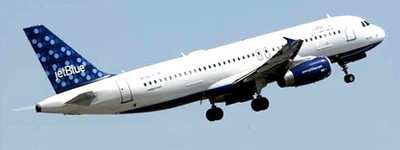Pact Will Bring GPS Precision To East Coast, Caribbean
Routes
The FAA and JetBlue have signed a NextGen agreement that will
allow the airline to fly more precise, satellite-based flights from
Boston and New York to Florida and the Caribbean beginning in
2012.

NextGen is the transformation of the U.S. national airspace
system from a ground-based system of air traffic control to one
based on satellites, which will enhance safety and reduce aviation
congestion. Thursday's NextGen announcement follows President
Obama’s State of the Union Address last week, in which he
stressed the importance of targeted investments to foster American
innovation that will make our nation more competitive globally and
strengthen our economy here at home.
“In his State of the Union address, President Obama called
for targeted investments that harness American innovation to
strengthen our nation,” said U.S. Transportation Secretary
Ray LaHood. “NextGen is a critical investment in the future
of our transportation system, one that uses the latest technology
to transform our airspace to make aviation safer, more efficient
and more environmentally friendly.”
Under the agreement, as many as 35 of JetBlue’s A320
aircraft will be equipped with Automatic Dependent
Surveillance-Broadcast (ADS-B) avionics over the next two years,
enabling them to fly in two major routes off the East Coast even if
traditional radar coverage is not available. The improved accuracy,
integrity and reliability of aircraft surveillance under ADS-B will
allow JetBlue to take advantage of these routes at all times since
the satellite-based system tracks the precise position of
aircraft.
The agreement will also allow JetBlue to fly a new route to the
Caribbean, and could lead to the development of two new, shorter
ADS-B-only routes to the Caribbean from Boston, New York and
Washington. The FAA will collect valuable NextGen data by observing
and conducting real-time operational evaluations of ADS-B on
revenue flights.

“NextGen will help improve the travel experience for
passengers and give airlines more flexibility to find the most
efficient way to reach their destinations,” said FAA
Administrator Randy Babbitt. “This agreement will allow us to
collect important data to further demonstrate the benefits of
NextGen.”
“As the youngest major airline in the United States, with
a majority of our operations in the Northeast – arguably the
most congested airspace in the world – JetBlue
enthusiastically joins the FAA in this effort to begin rebuilding
the skyways,” said JetBlue Airways CEO Dave Barger.
“Our investment today will yield dividends far into the
future, not just for JetBlue but for all airlines. Our customers
and crewmembers deserve our best efforts.”
The FAA has agreed to pay $4.2 million for the ADS-B avionics.
JetBlue will provide flight operations, pilots, and aircraft
maintenance and will pay for the cost of aircraft downtime while
the ADS-B avionics are installed. JetBlue will also fund the
necessary training for dispatchers and flight crews, including
simulator time. The airline will demonstrate the cost savings of
ADS-B technology and potentially equip the rest of its A320 fleet
at its own expense with ADS-B avionics.
 ANN's Daily Aero-Linx (05.02.24)
ANN's Daily Aero-Linx (05.02.24) ANN's Daily Aero-Term (05.02.24): Touchdown Zone Lighting
ANN's Daily Aero-Term (05.02.24): Touchdown Zone Lighting Aero-News: Quote of the Day (05.02.24)
Aero-News: Quote of the Day (05.02.24) ANN FAQ: Contributing To Aero-TV
ANN FAQ: Contributing To Aero-TV NTSB Final Report: Cirrus Design Corp SR20
NTSB Final Report: Cirrus Design Corp SR20




